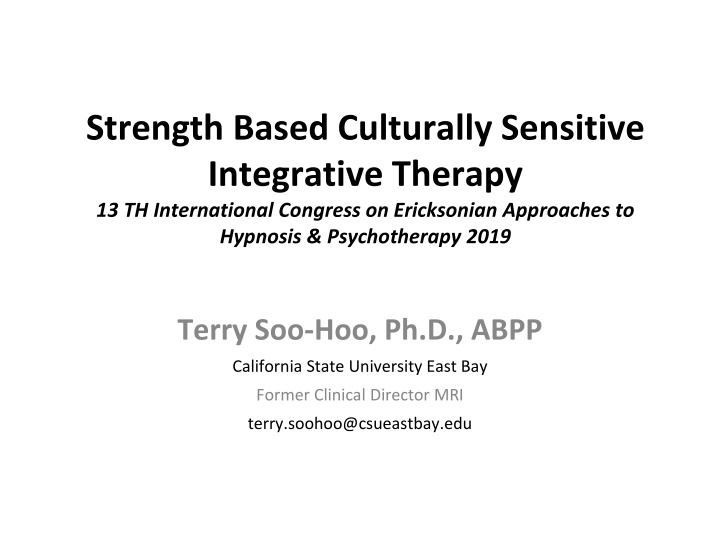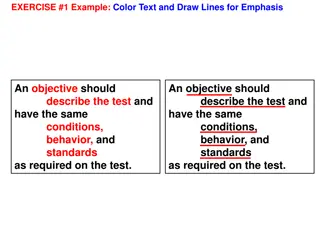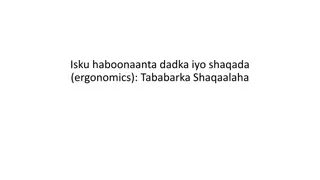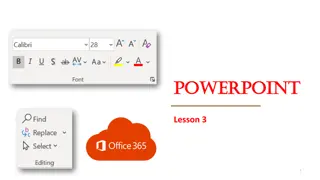
Strength-Based Culturally Sensitive Integrative Therapy
Explore the theory and practice of Strength-Based Culturally Sensitive Integrative Therapy, emphasizing the importance of entering the client's unique world, considering cultural influences, and activating clients' strengths for successful therapy outcomes. Discover how human problems develop, different types of solutions, and the pivotal role of therapist-client relationships in psychotherapy success.
Download Presentation

Please find below an Image/Link to download the presentation.
The content on the website is provided AS IS for your information and personal use only. It may not be sold, licensed, or shared on other websites without obtaining consent from the author. If you encounter any issues during the download, it is possible that the publisher has removed the file from their server.
You are allowed to download the files provided on this website for personal or commercial use, subject to the condition that they are used lawfully. All files are the property of their respective owners.
The content on the website is provided AS IS for your information and personal use only. It may not be sold, licensed, or shared on other websites without obtaining consent from the author.
E N D
Presentation Transcript
Strength Based Culturally Sensitive Integrative Therapy 13 TH International Congress on Ericksonian Approaches to Hypnosis & Psychotherapy 2019 Terry Soo-Hoo, Ph.D., ABPP California State University East Bay Former Clinical Director MRI terry.soohoo@csueastbay.edu
Module 1 Theory of Strength Based Culturally Sensitive Integrative Therapy What leads to Successful Therapy Outcomes How Human Problems Develop First Order vs Second Order Change Culture and Society
All Therapy Multicultural Therapy All Therapy begins with Entering Client s Unique World Therapist must see world through Client s eyes Therapist must understand that world to certain degree To Work within Client s unique world Error to force Client to work within Therapist s unique world This process assists in developing therapeutic alliance
What has Importance in Clients World Collectivists cultures vs individual oriented cultures Unique worlds beyond just culture Frames of reference related to problem How people see problem determines attempted solutions What shapes how people see problem
A. What Leads to Successful Psychotherapy Outcome Scott Miller 1. 30% - Strong Positive relationship between therapist and client 2. 40% - What clients bring to therapy a. Strengths and resources clients bring to therapy b. Client motivation for solving presenting problem 3. 15% - Therapist s theory and techniques and skill of therapist 4. 15% - Placebo Effect Belief in the therapist and the therapy 5. Activating Clients Strengths is unifying theme for all 3 Elements of Successful Treatment Outcome.
B. Theory 1. How human problems develop 2. First order and second order change 3. Types of attempted solutions 4. Constructivist view of reality 5. Culture and Society 6. Working within the clients unique world 6
1. How human problems develop a. Ineffective coping - mishandled difficult or challenging events b. Attempted solutions 1. Solutions that do not work will make Problem Worse 2. It will also Maintain the Problem a. Perception and meaning 1. Drives emotions 2. Drives attempted solutions
2. First order and second order change a. First order change change or solutions within the same category, keeps people stuck in repetitive problem cycles b. Second order change change or solutions in a different category, helps people develop new solutions that are in a different direction and breaks these negative ineffective cycles
3. Types of Attempted Solutions a. Trying too hard to control things that require letting go , eg. anxiety, sleep, etc. b. Over controlling or under controlling events and relationships 1. Pressuring people to change 2. Power struggles over who is right/wrong a. Confrontation vs avoidance of problem issues
4. Constructivist View of Reality a. Reality is constructed through messages from culture and society and interactions between important people in one s life. b. Negative ineffective constructions can be deconstructed c. New more useful constructions can be reconstructed
5. Culture and Society a. Culture & Society sends powerful messages that can be oppressive and generate problems b. These messages dictate how people should view the world and relationships c. These can be deconstructed and reconstructed to generate more positive, helpful, and effective meanings that assist the client to deal more effectively with the presenting problem d. It is possible to achieve mental liberation e. When to challenge cultural and social constructions and when to work within these constructions
6. Entering Clients World WorKing Within Client s World a. Therapist needs to view the world the way clients view it, acknowledge and validate the clients experiences within that view b. Is the client open to a shift in a particular view? If not then therapist works within that view c. Therapist needs to generate new solutions that are consistent with the clients cultural context d. Understanding the client s message content vs. process
Module 2 Strategic Therapy Interventions A. Steps B. Defining the problem C. Exploring perceptions and meanings D. What are the attempted solutions E. Generating new perspectives F. Breaking interactional cycle G. Activating strengths and mobilizing resources H. Working with ambivalence and conflicts I. Thinking out of the box J. Expanding perspectives K. Three types of clients L. Paradoxical interventions M.Using humour Case examples 14
A. Steps 1. Defining the problem 2. How does client view the problem, what has special meaning (frame of reference) 3. What have client tried (attempted solutions not working) 4. Changing perception (meaning) of the problem 5. 180 degree turn in the solutions 6. Maintaining change once improvement is initiated
B. Defining the Problem 1. Problems are observable and measurable 2. They should focus on something changeable and solvable with Brief Therapy 3. Goals of therapy can be to overcome blockages that frees the clients to proceed with their lives or get them on right path towards long term goals.
C. Exploring Perceptions and Meaning Keeping Client Stuck 1. How clients perceives problem drives attempted solutions that are not working. 2. We are always attributing meaning to any situation. 3. Certain meanings can lead to ineffective and problematic attempted solutions. 4. Perceptions of self, Perception of others, Perception of situation
D. Attempted Solutions Not Working 1. Attempted solutions: ways client trying to cope with problem that is not working. 2. Client using old coping that may have worked in past but not working in new problem situation. 3. Clients cannot stop old coping and adopt more effective new coping . 4. These solutions makes problem worse and keeps problem going 5. Need to Stop solutions that are not working 6. Do more of solutions that work
E. Generating New Perceptions of Problems Reframing 1. Frame of reference View of Problem - meanings attributed to problem situation 2. Helping client view the problem situation in new way. Reframing (ADHD as high energy that can be focused) 3. This new perception changes the meaning that the client is attributing to the problem situation. (Child s misbehavior is cry for help) 4. This new perception or meaning opens up new possible solutions that are more effective.
F. Breaking Interactional Cycle 180-degree Turn in Solution 1. Ineffective attempted solutions will lead to escalation of the problem. Also lead to maintaining the problem or keeps the problem going. This leads to interactional cycle of repeated attempts to solve problem. Each person provokes other person to respond in ways that escalates and keeps problem going. Second order change Not opposite but different direction of attempted solution (I know you care about me) False choices ( confrontation or avoidance ) 2. 3.
G. Activating Strengths and Mobilizing Resources 1.Exploring past successes, exceptions 2.Exploring positive attributes 3.From victim to survivor to thriver 4.Crisis can make someone stronger
H. Working with ambivalence and conflicted issues 1. Arguing both sides of the issue 2. Pros and Cons - Strengths and Weakness exercise 3. Allowing the client to struggle with issues 4. Restraining change
I. Thinking out of the box 1. Nine dot problem 2. Being creative 3. Innovative interventions 4. Therapeutic metaphors
J. Expanding perspective beyond self Externalizing the problem 1. View problem from other person s perspective 2. Understanding other person s inner world (What is going on with your husband) 3. View the problem as external to client
K. Three Types of Clients 1.Customer a. I have a problem b. I cannot solve problem by myself c. I need your help therapist 2.Complainer d. I have a problem e. I cannot solve problem by myself f. Says he needs therapist s help but is not ready to take action to change (Yes/But) g. Therapist needs to return problem back to the client, focus on consequences of change 3.Visitor h. Is sent to therapy by probation officer, spouses, teachers, parents, etc. i. Will not admit he has a problem j. Therapist needs to appeal to what is important to client, getting off probation .
L. Paradoxical Interventions 1. Breaks up rigid thinking and behaving 2. Changes rules of the game 3. Unbalances person so he has to give up rigid thinking and behaving to rebalance 4. Types of paradoxical interventions a. Prescribing the symptom b. Exaggeration c. Restraining change d. Pretend tasks e. Therapeutic ordeals f. Devils advocate
M. Humor in Psychotherapy 1. Humor One type of paradoxical intervention 2. Activates chemicals in body that counters negative emotions: depression, anxiety, anger, etc. 3. Humor breaks up rigid thinking and behavior patterns 4. Changes the rules of the game






















